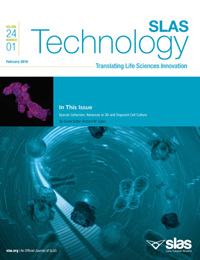For Immediate Release

SLAS News (Jan. 23, 2019) — A new collection of reviews and original research articles in SLAS Technology illustrate how new technologies and advanced cell culture are accelerating basic research, drug discovery and drug development.
When cultured under 3D conditions, human induced pluripotent stem cells (iPSCs) provide optimized systems that more accurately reflect disease-related target mutations, compound pharmacology and toxicology.
The review articles in this collection feature a comprehensive, two-part, overview of the use of 3D culture, including spheroids and organoids, when growing human iPSCs for use in disease modeling, compound screening and lead optimization. The research articles address the high-throughput screening of glioblastoma oncospheres in drug, a microfluidic approach to optimization of culture conditions for human iPSCs differentiation, and novel hydrogels for use in microlayered tissue constructs.
Collectively, this special collection, published in the February 2019 issue of SLAS Technology, illustrates how the human iPS cells and 3D cell culture technology provide powerful approaches to the development of novel and more effective therapies.
Free access to the SLAS Technology special collection on Advances in 3D and Organoid Cell Culture at http://journals.sagepub.com/toc/jlad/24/1 is sponsored by Corning Life Sciences. For more information about SLAS and its journals, visit www.slas.org/publications/slas-technology/. For more information about Corning Life Sciences, visit www.corning.com/lifesciences.
Image Credit: SLAS Technology February 2019 front cover images courtesy of Corning Life Sciences
*****
SLAS (Society for Laboratory Automation and Screening) is an international community of 18,000 professionals and students dedicated to life sciences discovery and technology. The SLAS mission is to bring together researchers in academia, industry and government to advance life sciences discovery and technology via education, knowledge exchange and global community building. For more information, visit www.slas.org.
Jill Hronek
Director of Marketing Communications
Telephone: +1.630.256.7527, ext. 103
E-Mail: jhronek@slas.org